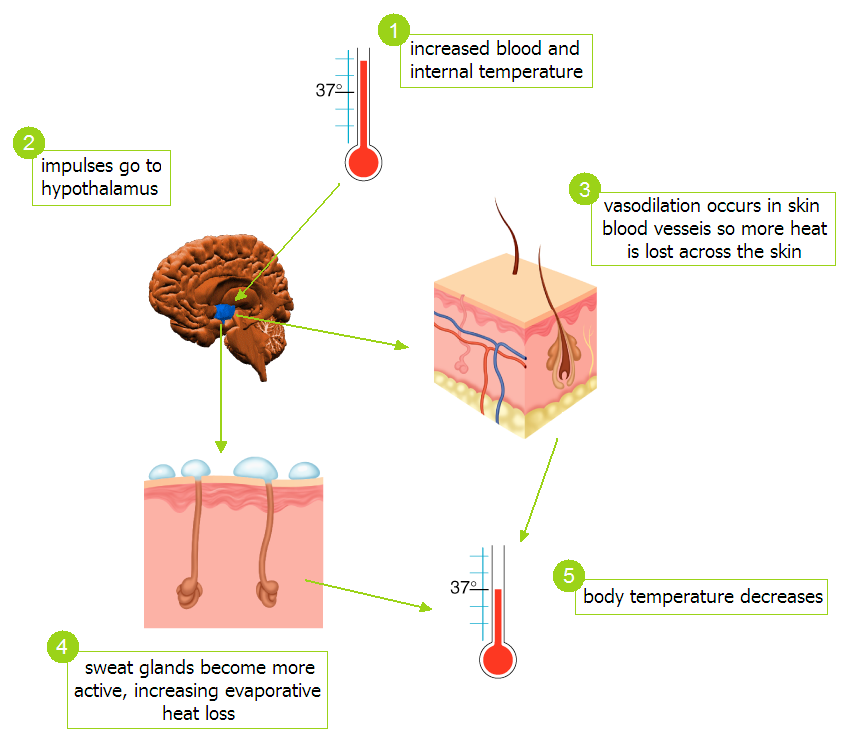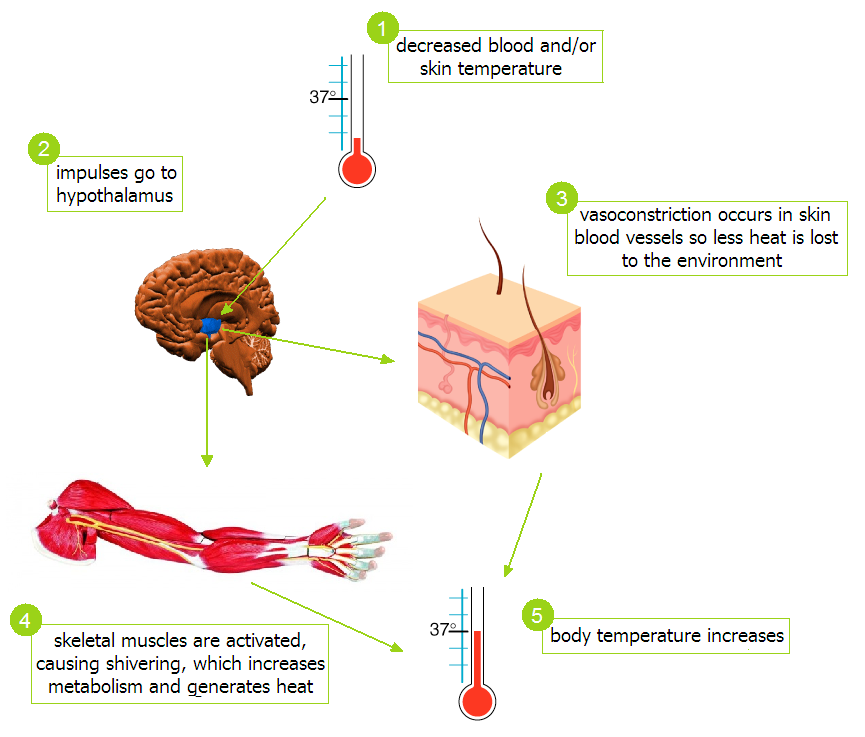
The environment tends to have a profound effect on sports performance. In the following charter we will look at how temperatures whether high or low tend to affect athletes' performance.
Thermoregulation
The body temperature is controlled by the brain. The hypothalamus works like a thermostat, it helps to keep and balance the natural body temperature. Under resting conditions the organism keeps a stable body temperature of 37°C.
If a person is exposed to higher temperatures in the immediate environment or is subjected to a movement activity which increases the body temperature, the body temperature rises. This upsets the homeostasis of the organism which sets off its defence mechanisms.
Response and adaptation of an organism to exercise in hot temperatures
The generation of heat occurs mainly in the nucleus, especially in the livers and muscles. Under workload up to 70% of heat is generated in muscles, the rest is produced in the other organs.
The following picture (Fig. 26) shows the major mechanisms of heat generation.
Figure 26 Mechanisms of heat generation

Mechanisms activated by heat according to Ganong (2005)
Increased heat generation:
- skin vasodilatation
- sweating (perspiration)
- more intensive breathing
Decreased heat generation:
- loss of appetite
- apathy and inactivity
Perspiration – evaporation (Rokyta, 2000, Hampl)
Perspiration presents the most effective mechanism of heat generation or output under physical workload. Through perspiration the body loses up to 80% of its heat while under resting conditions it is mere 10%. It is the only way of heat output in situations where the temperature of the environment is higher than the body temperature. Through perspiration sweat expelled through the skin surface gets evaporated thus taking away a certain amount of heat. Under physical workload this mechanism is launched by the adrenaline, while under resting conditions sweat glands are innervated by sympathetic cholinergic nerve fibres. The blood cools down in deep epidermis and progresses to deeper tissues. This manner of heat generation depends on the air humidity of the environment in question. The sweat evaporates faster when exposed to dry air than when exposed to humid air of the same temperature. In tropical forests of up to 90% humidity, sweat does not evaporate, it pours down the skin and the cooling is therefore not that effective. This is when the right choice of clothes becomes very important, it should never prevent sweat evaporation.
Sweat is produced by the sweat glands from plasma filtration. There are about 2.5 mil sweat glands in the human body, about 200 /1mm2 on a palm and 10-20/1mm2 on a trunk. Sweat is mostly formed by water, ions (Na+, K+ and Cl-), lactic acid and urea. In substantial perspiration the sweat tends to contain significantly more sodium and chlorides (in trained persons the losses of minerals tend to be smaller). Under heavy workload and in heat the body may lose up to 1 litre of sweat per hour per 1 m2 of the body surface. Unless liquid losses are not sufficiently compensated, dehydration may occur and basic life functions may be jeopardized.
Through evaporation the body loses water and ions (the daily loss of salt amounts to 15-30g). After a 1-6-week stay in a hot environment, sweat secretion increases to 2-3 litres per hour which may accelerate heat emission up to 10 times. Adaptation of the organism to heat results in increased water losses but this is compensated by decreased salt losses down to 3-5 g per day due to aldosterone effects.
Hyperthermia (organism overheating)
Organism overheating (Fig. 27) may result from physically demanding movement activity, hard work in hot weather, but also from being in crowded places such as at concerts etc. Overheating refers to the state of an organism where mechanisms in charge of thermoregulation stop working. The hypothalamus starts overheating and thus loses the ability to regulate the temperature. Hyperthermia symptoms include stoppage of perspiration, hot and dry skin, tachycardia and tachypnoea, confusion, faintness and unconsciousness. Overheating may affect persons of higher age or persons with cardiovascular diseases. Children and obese people may also run the risk of hyperthermia due to the hindered heat emission which results from higher insulation caused by the fatty layer in the latter.
Figure 27 Hyperthermia

Response of cardiovascular system to heat
Due to the transport of heat from muscles to surface body areas the cardiovascular system tends to become strained in heat. This situation leads to the increase of the minute cardiac output (Q), enhanced skin blood perfusion and deep epidermis blood perfusion which is compensated by the decrease in blood-perfusion to other areas (digestive and excretory system). The heart rate (HR) is growing in comparison with the workload in a cold environment.
Overheating prevention
Prevention of overheating includes lowering the intensity of workload and inclusion of frequent breaks in the shade. Persons in a hot environment are recommended to carry out physical exercise in the early morning or evening hours of the day. They are also advised to choose light and airy clothes capable of draining the sweat off the body surface.
Adaptation to heat
Repetitive workload in heat results in the enhanced ability of the organism to conduct heat away from the body and in the reduced risk of exhaustion and thermoregulation failure. Adaptation consists in the adjustment of perspiration and blood circulation. Acclimatized persons start sweating earlier and thus reduce their skin temperature. Significant temperature losses in heat enable the adapted people to transfer more blood to working muscles. Those adapted to heat show a lower body temperature and lower heart rate (HR) than those not acclimatized when under the same physical load.
Response and adaptation of an organism to workload in cold conditions
Cold stressors include cold water and cold air
Mechanisms activated by cold according to Ganong (2005):
Increase in the heat production through:
- muscle shivers
- hunger
- increased voluntary activity
- enhanced secretion of noradrenaline and adrenaline
Decrease in heat losses through:
- skin vasoconstriction
- lying curled up
- piloerection
Shiver
A shiver presents the most important defence mechanism against cold. It is caused by non-synchronized rhythmic muscle twitches which do not result in a changed position. This emerging muscle activity most probably derives from the reflex mechanism of the muscle spindle. Stress increases the generation of heat in an organism up to three times and simultaneously decreases skin blood-perfusion while raising blood-perfusion of muscles.
Non-shivering thermogenesis
Non-shivering thermogenesis derives from the effects of both adrenaline and noradrenaline from the sympathicus in brown fatty tissue (in newborn babies) and possibly also from white fatty tissues in skeletal muscles (in adults). The volume of heat thus produced is twice as big. Tyroxine contributes to heat generation by up to 50% in all the organs. This type of heat, however, gets activated only after a few weeks in a cold environment.
Hypothermia
Hypothermia (Fig. 28) occurs when core temperature drops below 35°C. In the first stage the body attempts to stop the temperature decrease by shivering, vasoconstriction and acceleration of the heart frequency. When the core temperature reaches the value of 30°C the person becomes unconscious. Temperature decline is accompanied by the decline in the basal metabolism which at the body temperature of 28°C drops to the half of its normal values. Managed hypothermia is used in heart and brain surgeries.
Figure 28 Hypothermia

Adaptation to cold
The International Commission for Thermal Physiology divided adaptation to cold into 4 groups (Máček, Radvanský, 2011)
- genetic (from the evolution point of view individuals living in colder climates are able to sleep in cold temperatures wearing fewer clothes and using fewer blankets that Central Europeans)
- acclimatization (acquired modifications in response to complex outside factors, such as seasonal and climatic changes)
- acclimatization (acquired modifications in response to the only environment factor (e.g. cold)
- adjustment – inhibited responses or reduced sensitiveness following repeated exposure to cold stimulus